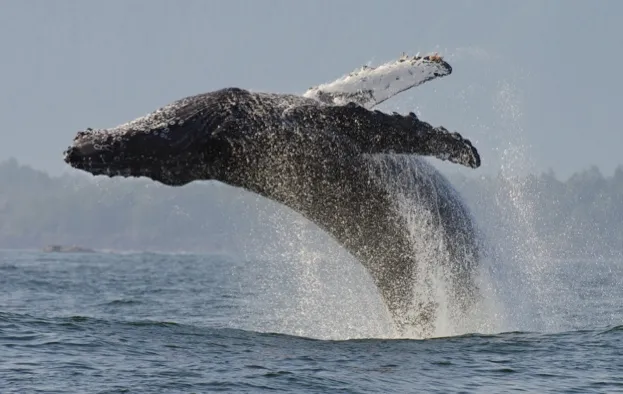Making and using tools was once thought to be a skill unique to humans, and a clear sign of our superior intellect compared to other animals.
However, in 1960 famous primatologist Dr Jane Goodall made an incredible discovery. She witnessed one of her wild chimpanzee subjects stripping the leaves off a twig and then, with great deliberation, poking it into a termite mound.
After pulling it out he carefully plucked the insects off the twig with his lips, gaining himself a nutritious little meal. This chimpanzee was engaging in tool use. Upon receiving news of this discovery Goodall’s mentor, the esteemed palaeoanthropologist Louis Leaky, famously declared “Now we must redefine ‘tool,’ redefine ‘man’ or accept chimpanzees as human”.
Leaky hit upon something significant here - what exactly is the definition of tool use? What counts and what doesn't? This is more contentious than you might think, and a huge number of different definitions have been concocted by cognitive psychologists and zoologists.
Which animals can be said to be tool users depends very much on the definition you employ. These definitions can be very wordy, but put simply(ish) a generally accepted definition might be - tool use is when an animal uses an unattached and movable object to alter something about another object or animal, they carry or hold the object just before use, and orientate it properly when using it.
This definition encompasses a variety of behaviours, from the aforementioned termite fishing of chimpanzees to fish that use rocks to crack open mollusk shells. As you will learn, since the 1960s it is not just other primates that have been discovered to use tools, but those of many varied species. Read on to find out more about tool-using animals.
Top 11 tool-using animals
Humpback whales

Yes humpback whales have been found to use tools. In south-east Alaska scientists discovered the whales create and modify tools to help them hunt prey.
The tools in question are 'bubble nets', krill-catching devices used in a way that is "wholly unique to humpback whales", according to a new study published in Royal Society Open Science.
The team observed the whales blowing bubbles in patterns, forming nets with internal rings; the number of rings, the size and depth of the net, and the spacing between bubbles were skilfully controlled by the humpbacks.
Chimpanzees
In addition to termite fishing chimpanzees use tools for many other purposes. Much of chimpanzee tool use is in the context of extractive foraging - i.e. digging out food from trees or the ground. This includes using sticks to extract larvae from tree bark and honey from bee hives.
They also use rocks to crack nuts for eating and crush up leaves to use as sponges to obtain water. Chimps do however use tools in non-food-related contexts too. They have been seen to use sticks, branches, and rocks as weapons and in aggressive displays for example, both towards other chimpanzees at predators such as leopards. Aside from humans, chimpanzees are thought to show the greatest diversity of tool-use behaviours in the animal kingdom.
Capuchin monkeys (Cebus apella)
Within the field of animal behaviour tool use has been most extensively studied within primates. This is in part because knowing about how our evolutionary cousins use tools can tell us about how our own species became such proficient tool users. It shines a light on primate problem-solving behaviour, how tool use is learned and passed on, and what environmental conditions might be important in its evolution.
Amongst monkeys, capuchins are particularly skilled tool users. They frequently use rocks to smash open hard fruit and nuts, selecting the best tools for the job based on weight and durability. This ability to think about the properties of the tools they are using in relation to the food that needs to be cracked reveals especially good problem-solving abilities.
New Caledonian Crows (Corvus moneduloides)
It is not only our close relatives that use and make tools, however, but more distantly related species also. Corvids - the group of birds containing crows, ravens, and magpies amongst others - are known to be particularly proficient tool users. New Caledonian Crows are a standout within this group. Not only do they regularly use stick tools for extractive foraging, they also have sophisticated tool manufacture abilities.
These crows trim and bend twigs, leaves, and sometimes wires, with their beaks to form very effective hooked tools that are perfect for pulling larvae out of tree bark. The ability to create tools for specific purposes is rare and thought to be indicative of advanced motor skills as well as cognitive abilities such as future planning and insight.
- Crafty crows can create tools fit for purpose
- Crows have a reputation for being smart, but are they actually clever?
Kea (Nestor notabilis)
Other birds than just corvids are accomplished tool users also. This includes Kea, a large, green and playful parrot species native to New Zealand. Kea are known for their intelligence and have been discovered to posses many complex skills.
They can solve tricky logic puzzles, make predictions about the future, and work together in groups to get food. They are not habitual tool users in the wild, in part due to their diet which consists mainly of seeds, nuts and fruit which they can process with their strong beaks without the need for foraging tools. However, in captivity their smarts and behavioural flexibility has shone through and they have worked out how to use stick tools to get food from puzzle boxes.
Tool use has also been observed in a self-care context, with one kea with a broken beak (called Bruce) seen using sticks to preen himself.
Coconut octopus (Amphioctopus marginatus)
Although accepted to occur in non-humans, until very recently tool use was considered to be restricted to vertebrates (like primates and birds). That was until researchers documented octopuses carrying around coconut shell halves and using them as handy shelters and lairs.
This behaviour is thought to constitute tool use as the gastropods lug around the shells for a considerable distance prior to use and at a cost to themselves. The shells are cumbersome and ungainly to carry, making movement inefficient and the animals more vulnerable to predators. The fact that they do this implies that they are planning for the future use of the shells for a particular purpose, a sophisticated cognitive feat, and sets the behaviour apart from more simple object manipulation.
- Squid vs octopus: what's the difference between these multiple-limbed sea creatures?
- Why do female octopuses die after reproducing?
Bottlenose dolphins (Tursiops genus)
Another sea-dwelling tool user is the bottlenose dolphin. The case of this intelligent marine mammal highlights something particularly fascinating. This species has been observed using marine sponges as tools to probe the seafloor and dig up prey. However, the behaviour has only been documented in the female members of just one small group of dolphins living in Shark Bay Australia.
These females appear to pass the behaviour onto their daughters but not their sons. Even more remarkably, genetic evidence has suggested that all sponge users are descended from just one innovative female - a “sponging Eve”. The local specificity and transmission of this behaviour through generations mean that it has been classified as a cultural tradition - something once thought to be unique to humans.
African elephants (Loxodonta africana)

Another species that has been added to the growing list of tool using animals in recent decades is African elephants. They have been seen to use heavy branches to weigh down fences so that they can climb over, use sticks as weapons against humans, and clean their ears with grass.
Perhaps stretching the aforementioned definition of tools use (which specifies use of an object) elephants have even been documented using water as a tool. When captive elephants were presented with a so-called ‘floating object task’ - in which a food reward is placed at the bottom of a transparent tube out of reach, floating in small amount of water - they worked out how to add more water to the tube, raising the water level and thus the treat so that they could eat it. This demonstrated their ability to solve new problems with tool use.
Sea otters (Enhydra lutris)
Perhaps one of the more well-known animal tool use examples is that of the stone tools of sea otters. These marvellous mustelids use rocks to bash open the hard shells of marine molluscs to get at the tasty flesh within. They even have a favourite tool rock that they will keep in a specialised pocket in their fur! To break open the shellfish they lie on their backs on the water’s surface, place it on their chests, and hit repeatedly with the rock. They can do this with incredible speed and force, making them able to crack open even really hard shells that would be impossible to break using their teeth. Tool use therefore enables this species to obtain valuable food that would otherwise be inaccessible to them.
California sheephead wrasse (Semicossyphus pulcher)

As we have seen, tool use is in many cases a very useful strategy to extract food. With efficient foraging being so critical to animal survival it is easy to see why so many species might have evolved tool use behaviours to help them. This extends to animals that you might not expect. For example, otters are not the only species to use rocks to smash open their food, some fish do it too!
Multiple individuals of this temperate wrasse species have been observed using rocks as an anvil to crush hard-bodied invertebrate prey, such as urchins. These are not the only fish that have been seen using tools either, numerous other wrasse species could be included in our list, as well as potentially archerfish and stingrays. These observations demonstrate that complex behaviours can be found even in overlooked species that are not considered to be particularly brainy.
Great Blue Heron (Ardea herodias)

Using tools to get food is not always as simple as smashing something open. Several species of bird have been recorded exhibiting a behaviour known as ‘bait fishing’. This involves placing an object, such as a piece of bread, into water, attracting fish which the bird will then capture and eat. This behaviour falls into the definition of tool-use, and at face value appears to be remarkably clever.
However, the occurrence of tool use in and of itself does not necessarily imply special intelligence. Even very complex-looking behaviours can be acquired through quite simple learning processes. For example, in the case of heron bait fishing, it is thought that the birds have learned to associate floating objects with the presence of fish. They may then have learned to collect and position objects to achieve this outcome, without the need for a sophisticated understanding of the cause and effect.

